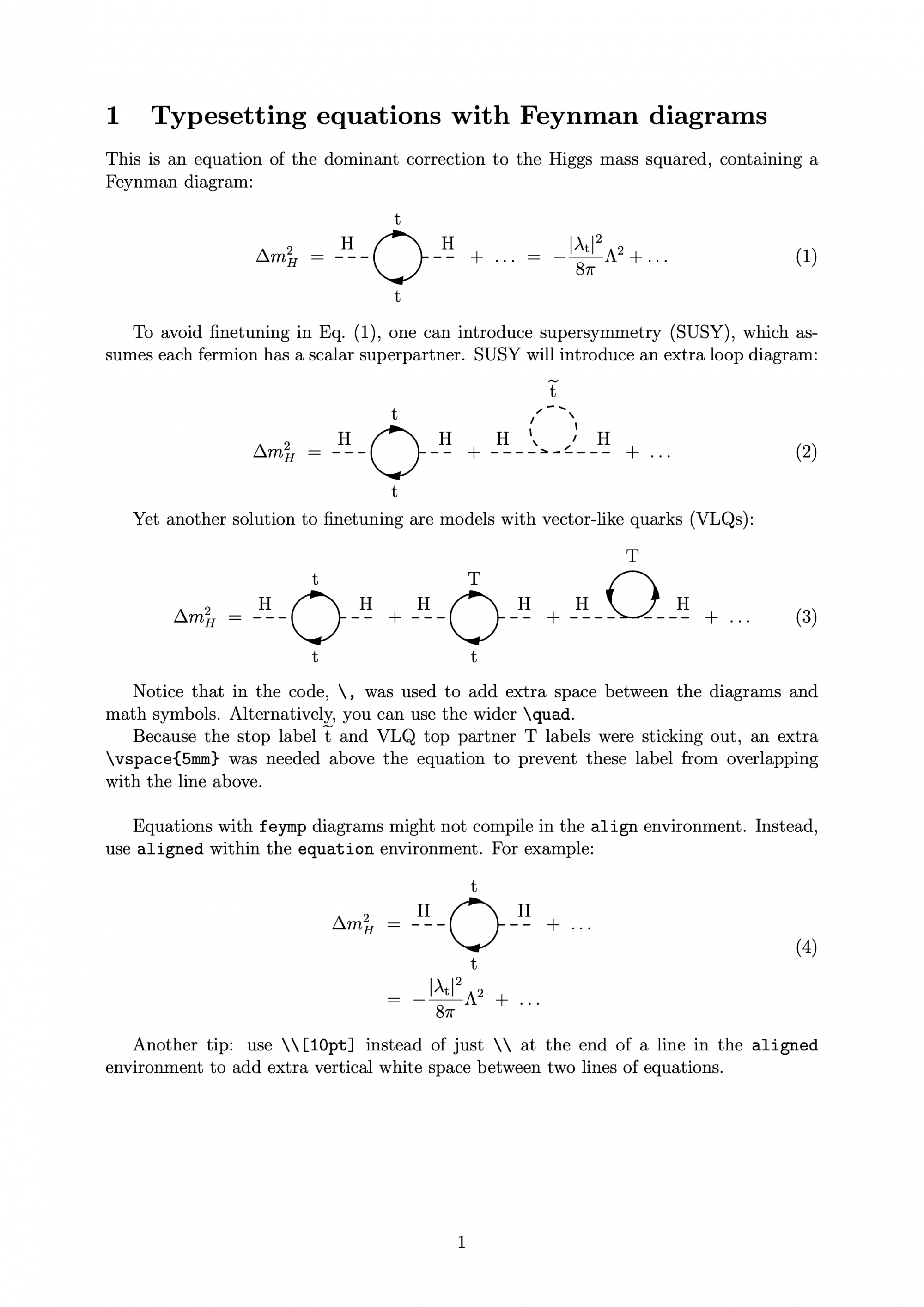User Tools
latex:feynman_equation_file
This file show how you can typset a text with Feynman diagrams in equations. See these instructions to compile the diagrams without the need for extra scripts or commands.
- feynman_equations.tex
% !TEX program = pdflatexmk % !TEX parameter = -shell-escape % Author: Izaak Neutelings (July 2017) \documentclass[a4paper,12pt]{article} \usepackage[margin=2.4cm]{geometry} % margins \usepackage{amsmath} \usepackage{graphicx} \usepackage{feynmp-auto} \begin{document} \section{Typesetting equations with Feynman diagrams} This is an equation of the dominant correction to the Higgs mass squared, containing a Feynman diagram: \begin{equation}\label{eq:hierarchy_problem} \begin{fmffile}{higgs_mass_correction} \Delta m_H^2 \,\, = \,\,\parbox{80pt}{ \begin{fmfgraph*}(80,60) \fmfleft{i} \fmfright{o} \fmfv{label=H,l.a=60}{i} \fmfv{label=H,l.a=120}{o} \fmf{dashes,tension=1}{i,v1} % ,label=H,label.side=left \fmf{dashes,tension=1}{v2,o} \fmf{fermion,left,tension=0.4,label=$\text{t}$}{v1,v2,v1} \end{fmfgraph*}} \,\, + \,\,\ldots \,\, = \,\, -\frac{|\lambda_\text{t}|^2}{8\pi}\Lambda^2 + \ldots \end{fmffile} \end{equation} % SUSY To avoid finetuning in Eq.~\eqref{eq:hierarchy_problem}, one can introduce supersymmetry (SUSY), which assumes each fermion has a scalar superpartner. SUSY will introduce an extra loop diagram: \vspace{5mm} \begin{equation}\label{eq:hierarchy_problem_SUSY} \begin{fmffile}{higgs_mass_correction_SUSY} \Delta m_H^2 \,\, = \,\,\parbox{80pt}{ \begin{fmfgraph*}(80,60) \fmfleft{i} \fmfright{o} \fmfv{label=H,l.a=60}{i} \fmfv{label=H,l.a=120}{o} \fmf{dashes,tension=1}{i,v1} % ,label=H,label.side=left \fmf{dashes,tension=1}{v2,o} \fmf{fermion,left,tension=0.4,label=$\text{t}$}{v1,v2,v1} \end{fmfgraph*}} \,\, + \,\,\parbox{80pt}{ \begin{fmfgraph*}(80,60) \fmfleft{i} \fmfright{o} \fmftop{m} \fmfv{label=H,l.a=60}{i} \fmfv{label=H,l.a=120}{o} \fmflabel{$\widetilde{\text{t}}$}{m} \fmf{dashes,tension=1}{i,v1} \fmf{dashes,tension=1}{v1,o} \fmf{dashes,right,tension=0}{v1,m,v1} \end{fmfgraph*}} \,\, + \,\,\ldots \end{fmffile} \end{equation} % VLQ Yet another solution to finetuning are models with vector-like quarks (VLQs): \vspace{5mm} \begin{equation}\label{eq:hierarchy_problem_VLQ} \begin{fmffile}{higgs_mass_correction_VLQ} \Delta m_H^2 \,\, = \,\,\parbox{80pt}{ \begin{fmfgraph*}(80,60) \fmfleft{i} \fmfright{o} \fmfv{label=H,l.a=60}{i} \fmfv{label=H,l.a=120}{o} \fmf{dashes,tension=1}{i,v1} % ,label=H,label.side=left \fmf{dashes,tension=1}{v2,o} \fmf{fermion,left,tension=0.4,label=$\text{t}$}{v1,v2,v1} \end{fmfgraph*}} \,\, + \,\,\parbox{80pt}{ \begin{fmfgraph*}(80,60) \fmfleft{i} \fmfright{o} \fmfv{label=H,l.a=60}{i} \fmfv{label=H,l.a=120}{o} \fmf{dashes,tension=1}{i,v1} % ,label=H,label.side=left \fmf{dashes,tension=1}{v2,o} \fmf{fermion,left,tension=0.4,label=$\text{t}$}{v2,v1} \fmf{fermion,left,tension=0.4,label=$\text{T}$}{v1,v2} \end{fmfgraph*}} \,\, + \,\,\parbox{80pt}{ \begin{fmfgraph*}(80,60) \fmfleft{i} \fmfright{o} \fmftop{m} \fmfv{label=H,l.a=60}{i} \fmfv{label=H,l.a=120}{o} \fmflabel{$\text{T}$}{m} \fmf{dashes,tension=1}{i,v1} \fmf{dashes,tension=1}{v1,o} \fmf{fermion,right,tension=0}{v1,m,v1} \end{fmfgraph*}} \,\, + \,\,\ldots \end{fmffile} \end{equation} Notice that in the code, \verb|\,| was used to add extra space between the diagrams and math symbols. Alternatively, you can use the wider \verb|\quad|. Because the stop label $\widetilde{\text{t}}$ and VLQ top partner T labels were sticking out, an extra \verb|\vspace{5mm}| was needed above the equation to prevent these label from overlapping with the line above.\\ Equations with \verb|feymp| diagrams might not compile in the \verb|align| environment. Instead, use \verb|aligned| within the \verb|equation| environment. For example: \begin{equation} \begin{aligned} \Delta m_H^2 \,\, &= \begin{fmffile}{higgs_mass_correction} \,\,\parbox{80pt}{ \begin{fmfgraph*}(80,60) \fmfleft{i} \fmfright{o} \fmfv{label=H,l.a=60}{i} \fmfv{label=H,l.a=120}{o} \fmf{dashes,tension=1}{i,v1} % ,label=H,label.side=left \fmf{dashes,tension=1}{v2,o} \fmf{fermion,left,tension=0.4,label=$\text{t}$}{v1,v2,v1} \end{fmfgraph*}} \,\, + \,\,\ldots \end{fmffile}\\ %[10pt] % to add extra vertical white space between the line &= \,\, -\frac{|\lambda_\text{t}|^2}{8\pi}\Lambda^2 \,\, + \,\,\ldots \end{aligned} \end{equation} Another tip: use \verb|\\[10pt]| instead of just \verb|\\| at the end of a line in the \verb|aligned| environment to add extra vertical white space between two lines of equations. \end{document}
latex/feynman_equation_file.txt · Last modified: by iwn


